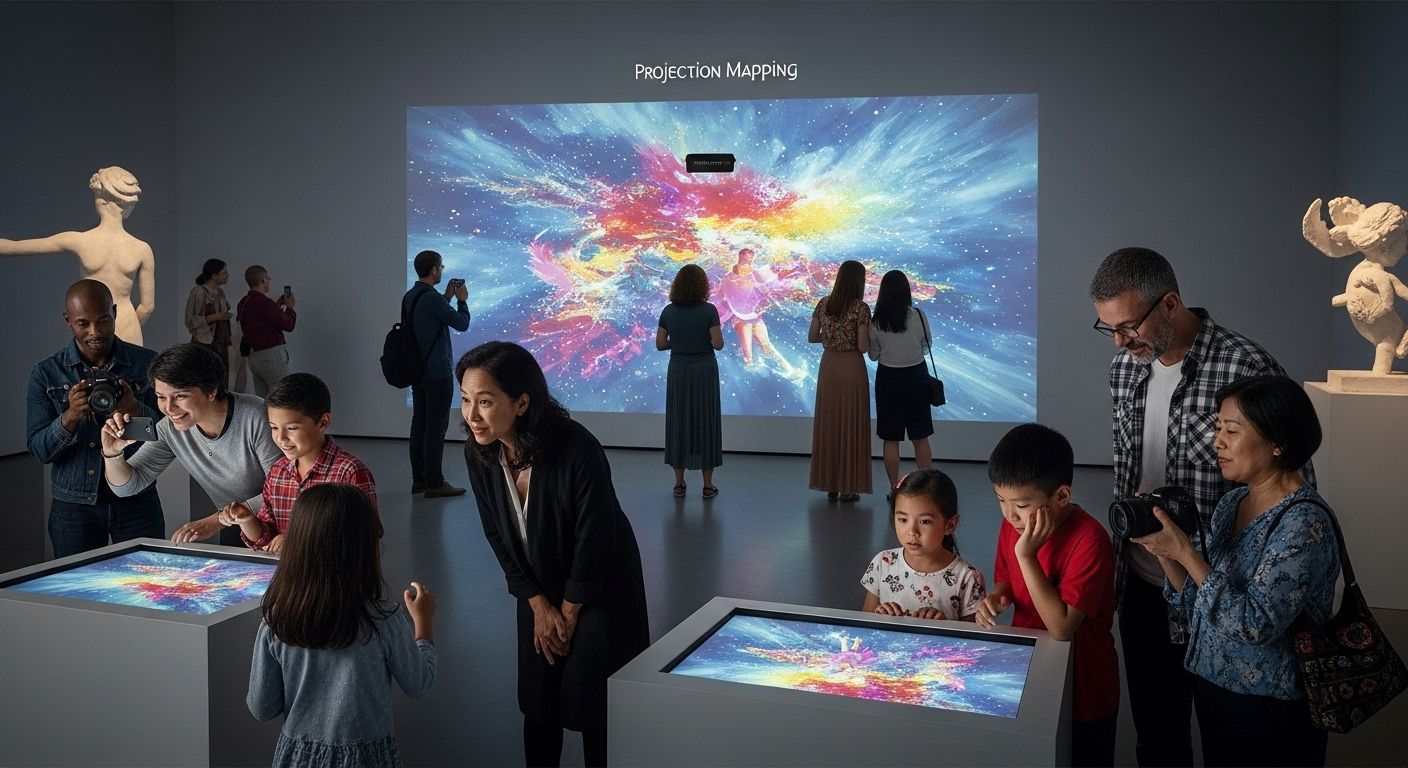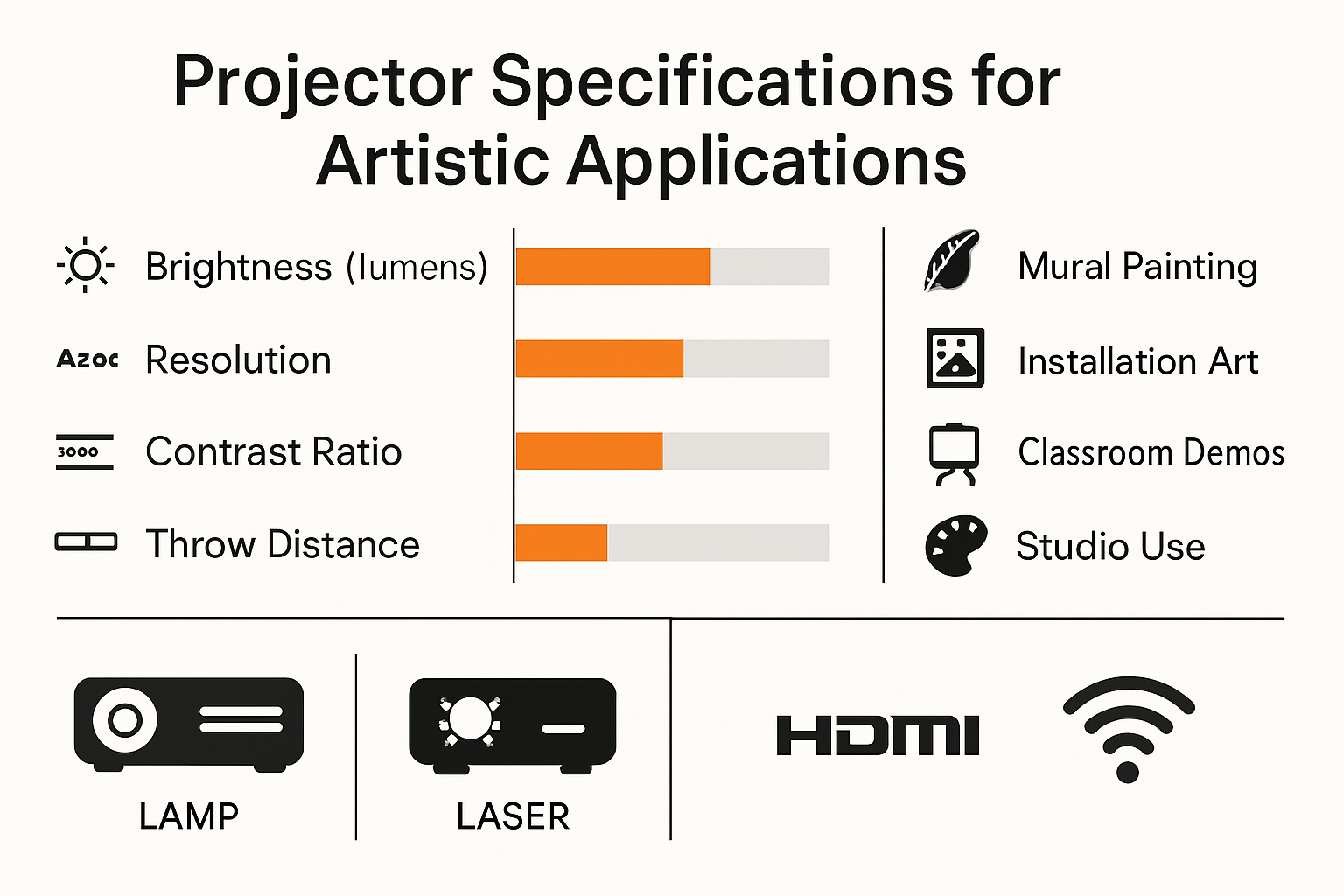Projectors are showing up everywhere in creative spaces now and artists are tapping into their surprising versatility. It may seem like a tool reserved for classrooms or corporate presentations, but projectors have become a studio secret that's changing how we imagine, teach, and collaborate on art. With the ability to transform static surfaces into dynamic canvases and allow artists to manipulate composition and scale instantly, projectors can unlock new worlds of expression and even help artists boost collaboration and reach across distances like never before. Get ready to see how this simple device is revolutionizing the way art gets made.
Table of Contents
- Benefits Of Using Projector For Art
- How To Set Up Your Projector For Art
- Creative Art Projects With A Projector
- Choosing The Right Projector For Your Needs
Quick Summary
| Takeaway | Explanation |
|---|---|
| Projectors enhance artistic techniques. | They allow artists to manipulate scale, proportion, and composition dynamically and precisely, fostering greater creativity. |
| Ideal settings improve projection quality. | Select dark rooms with smooth, neutral surfaces to achieve high image clarity and color accuracy in your art projects. |
| Invest in specialized projectors for art. | Different artistic needs require specific projector features, such as resolution and color accuracy, to ensure quality outputs. |
| Use interactive techniques for audience engagement. | Interactive art projects can respond to viewer movements, creating immersive and participatory experiences that captivate audiences. |
| Experiment with projection mapping for innovation. | This technique transforms physical objects into visual narratives, pushing the boundaries of traditional art forms and achieving dynamic storytelling. |
Benefits of Using Projector for Art
Artists and educators are discovering transformative ways to leverage projectors as powerful creative tools that expand artistic possibilities and enhance learning experiences. Using projectors for art opens up innovative approaches to design, teaching, and visual expression that were previously challenging or impossible.
Enhancing Creative Visualization and Technique
Projectors provide artists with unprecedented opportunities to explore and experiment with visual concepts. Learn more about creative projection techniques can help artists scale, trace, and transform their artistic visions with remarkable precision. According to The Art of Education University, projectors enable artists to demonstrate complex processes, share detailed visual content, and create interactive learning environments.
The ability to project images onto various surfaces allows artists to experiment with scale, proportion, and composition in ways traditional methods cannot match. Whether creating large murals, precise architectural drawings, or intricate design projections, artists can now manipulate visual elements with unprecedented flexibility. By using projectors, creators can instantly resize, rotate, and overlay images, providing a dynamic approach to artistic development.
Expanding Educational and Collaborative Opportunities
In educational settings, projectors revolutionize art instruction by promoting accessibility and engagement. Engineers Network highlights how projectors facilitate collaborative art projects and integrate seamlessly with STEM and STEAM learning approaches. Instructors can demonstrate techniques in real time, share global artistic references, and create interactive learning experiences that transcend traditional classroom limitations.
Artists and students can now collaborate remotely, share complex visual concepts, and explore artistic techniques through high-resolution projections. This technology breaks down geographical barriers, allowing artists to connect, learn, and create together regardless of physical distance. The projector becomes more than a tool – it transforms into a bridge connecting creative minds across different contexts and environments.
Technological Precision and Creative Exploration
Modern projectors offer artists unprecedented technological capabilities. High-resolution projection systems enable minute detail reproduction, allowing artists to explore intricate design elements with remarkable accuracy. Digital artists, graphic designers, and multimedia creators can use projectors to map complex visual narratives, create immersive installations, and experiment with projection mapping techniques.
From architectural visualizations to interactive art exhibitions, projectors provide artists with a versatile platform for creative expression. The technology allows for real-time adjustments, layering of visual elements, and exploration of spatial relationships that traditional art mediums cannot easily achieve. By integrating projector technology, artists expand their creative horizons and challenge conventional artistic boundaries.
Using projectors for art is not just about technological convenience – it represents a fundamental shift in how artists conceptualize, create, and share their visual narratives. As technology continues to evolve, projectors will undoubtedly play an increasingly significant role in artistic innovation and educational transformation.
How to Set Up Your Projector for Art
Setting up a projector for artistic purposes requires careful planning and technical understanding to achieve optimal creative results. Artists must consider multiple factors to transform their projector into a powerful artistic tool that enables precise visual expression and innovative techniques.
Choosing the Right Projection Environment
Creating the ideal projection space is crucial for artistic success. Learn more about proper projector mounting to ensure optimal image quality and positioning. According to the Victoria and Albert Museum, understanding your projection environment involves several critical considerations.
Key factors include room darkness, surface texture, and projection angle. Artists should select spaces with minimal ambient light and smooth, neutral-colored surfaces that can effectively receive projected images. White or light gray walls work best, providing maximum contrast and color accuracy. Consider using specialized projection screens for more professional results, which can enhance image clarity and color reproduction.
Technical Setup and Calibration
For readers planning their art projection setup, this table organizes key environmental factors and setup considerations highlighted in the article that can affect project outcomes.
| Setup Factor | Recommendation | Impact on Art Projection |
|---|---|---|
| Room Darkness | Use spaces with minimal ambient light | Improves image clarity and contrast |
| Surface Texture | Prefer smooth, neutral-colored walls or dedicated projection screens | Enhances color accuracy |
| Projection Angle | Adjust for perpendicular projection when possible | Avoids distortion, maintains focus |
| Throw Distance | Calculate appropriate distance for desired image size | Controls scale and sharpness |
| Stable Mounting | Use tripods or mounts for projector stability | Keeps image aligned and consistent |
Precise technical setup distinguishes amateur from professional projection art. The Fashion Institute of Technology emphasizes the importance of careful projector positioning and calibration. Artists must pay attention to several technical parameters to achieve optimal results.
Begin by calculating the throw distance – the space between the projector and the projection surface. Most projectors have adjustable zoom and keystone correction features that allow fine-tuning of image size and alignment. Experiment with different distances and angles to find the most suitable configuration for your specific artistic project. Consider using a tripod or specialized mounting system to ensure stable and precise positioning.
Software and Creative Techniques
Modern projection art extends beyond simple image display into complex digital manipulation. Adobe's insights on projection mapping reveal the sophisticated software and techniques available to contemporary artists. Digital tools now allow for intricate image warping, real-time adjustments, and complex visual storytelling.
Invest time in learning projection mapping software that enables creative transformations. Programs like MadMapper, Resolume, and Adobe After Effects offer powerful tools for artists to manipulate projected images dynamically. These applications allow for layer blending, color correction, and spatial transformation, turning projection into an interactive artistic medium.
Successful projector setup for art requires a blend of technical precision and creative vision. By understanding your equipment, environment, and digital tools, artists can unlock extraordinary possibilities for visual expression. The projector becomes more than a device – it transforms into a canvas of infinite potential, bridging technology and artistic imagination.
Creative Art Projects with a Projector
Projectors have revolutionized artistic expression, offering creative professionals and enthusiasts innovative ways to explore visual storytelling and design. Learn more about advanced projection techniques to unlock your artistic potential and transform ordinary spaces into extraordinary canvases.
Projection Mapping and Immersive Art Installations
Projection mapping represents a cutting-edge artistic technique that transforms ordinary objects into dynamic visual narratives. According to Wikipedia's exploration of projection mapping, artists can now add dimensions and movement to static surfaces, creating breathtaking visual experiences. Artists like Davy and Kristin McGuire have pioneered this approach, demonstrating how projectors can turn simple objects into complex storytelling platforms.
Creative professionals can experiment with various surfaces – from architectural facades to sculptural forms. Imagine transforming a blank wall into a living canvas that shifts and changes with projected imagery. Museums, galleries, and public spaces increasingly utilize this technique to create immersive experiences that engage viewers in unprecedented ways. By layering digital content onto physical structures, artists can generate multi-dimensional narratives that blur the lines between physical and digital art forms.

Interactive Art and Digital Storytelling
The Art of Education University highlights the transformative potential of projectors in creating interactive art experiences. Artists can now design projects that respond to viewer movements, create collaborative installations, and develop engaging multimedia presentations.
Interactive projection art opens numerous creative possibilities. For instance, artists can create environments where viewer movements trigger visual changes, or design collaborative installations that allow multiple participants to simultaneously interact with projected imagery. Educational institutions and art galleries are increasingly adopting these techniques to create more engaging and participatory art experiences.
Experimental Techniques and Mixed Media Art
Projectors enable artists to push traditional artistic boundaries by combining digital and analog techniques. By projecting images onto various surfaces – canvas, sculpture, live performers, or unconventional materials – creators can develop hybrid art forms that challenge conventional artistic categorizations.
Experimental artists might project onto moving objects, human bodies, or natural landscapes, creating ephemeral art experiences that exist only momentarily. This approach allows for unprecedented levels of creativity, enabling artists to experiment with layering, transparency, and spatial relationships in ways previously impossible.
The convergence of technology and artistic expression through projectors represents more than a mere technical innovation. It signifies a fundamental shift in how we conceptualize art creation, interaction, and perception. As digital tools become more sophisticated, artists will continue to discover increasingly complex and nuanced ways of using projectors to communicate, challenge, and inspire audiences worldwide.
Choosing the Right Projector for Your Needs
Selecting the ideal projector for artistic applications requires careful consideration of multiple technical and creative factors. Explore comprehensive projector types to understand the nuanced requirements for different artistic projects and visual expressions.
Understanding Projector Specifications for Art
Artists must pay close attention to specific technical specifications that directly impact visual quality and creative potential. According to The Slade Knowledge Base, crucial factors include lumens, resolution, contrast ratio, and throw distance – each playing a critical role in determining projection performance.

Lumens measure brightness, which is essential for art projects involving varying lighting conditions. Higher lumen counts enable clearer projections in spaces with ambient light, while lower lumens work best in controlled, darker environments. Resolution determines image clarity – with 1080p and 4K options providing increasingly detailed visual representations. Artists working on intricate visual projects should prioritize higher resolutions to capture minute details and maintain image sharpness.
Specialized Projector Types for Artistic Applications
To help artists and educators quickly compare different projector types for artistic use, the following table summarizes key features and considerations mentioned in the article.
| Projector Type | Key Features | Best For |
|---|---|---|
| Short-Throw Projector | Large images at minimal distance, flexible positioning | Digital artists, small studio spaces |
| Laser Projector | Consistent color accuracy, long lifespan, low maintenance | Professional installations, continuous display |
| Lamp-Based Projector | Traditional technology, lower initial cost | Entry-level use, occasional projects |
| High-Resolution (4K/1080p) | Detailed image clarity, sharper projection | Intricate art, detailed projections |
| Portable/Mini Projector | Compact, easy to move, simple setup | Quick setups, demonstrations, classrooms |
Different artistic disciplines require specific projector characteristics. Digital artists might prefer short-throw projectors that can create large images from minimal distances, while installation artists could benefit from models with advanced color reproduction and flexible mounting options.
Laser projectors offer significant advantages for professional artistic applications. These projectors provide consistent color accuracy, longer lifespans, and minimal maintenance compared to traditional lamp-based models. They generate less heat, operate more quietly, and maintain image quality over extended periods – critical considerations for long-term art installations and continuous projection projects.
Budget and Performance Considerations
Balancing artistic vision with financial constraints requires strategic projector selection. Professional-grade projectors can range from affordable entry-level models to high-end systems costing thousands of dollars. Consider your specific artistic requirements, project complexity, and long-term usage when making your investment.
Key considerations include connectivity options, lens shift capabilities, and compatibility with various media sources. Artists should evaluate projectors that offer multiple input types – HDMI, USB, wireless connectivity – to ensure seamless integration with digital design tools and creative workflows. Some projectors include built-in software features that can enhance artistic manipulation and presentation, providing additional value beyond basic projection capabilities.
Choosing the right projector transcends technical specifications – it represents an investment in your creative potential. By understanding your artistic goals, technical requirements, and budgetary constraints, you can select a projector that becomes an extension of your creative vision, transforming abstract ideas into vivid, dynamic visual experiences.
Frequently Asked Questions
What are the benefits of using a projector for art?
Using a projector for art allows artists to enhance their creative techniques by manipulating scale and composition easily, expand educational and collaborative opportunities, and explore artistic innovation through technological precision.
How do I set up my projector for optimal artistic results?
To set up your projector successfully, create a dark environment with smooth, neutral surfaces, calibrate the projector's angles and throw distance, and utilize specialized software for advanced image manipulation.
What features should I look for when choosing a projector for artistic applications?
Look for projectors that offer high resolution, a suitable brightness level (lumens), good color accuracy, and sufficient connectivity options to support your artistic tools and techniques.
What types of projects can I create with a projector?
You can create various projects, including projection mapping installations, interactive art displays, and mixed media art by projecting images onto a wide array of surfaces, from canvas to live performers.
Bring Your Art to Life With Professional Projection
Do you ever struggle to get your art projects looking just right because your current equipment limits your creativity? Maybe you want better clarity when tracing designs, or feel frustrated by projection that doesn't truly capture your vision. The article showed how precision, scale and vivid color are essential for artists and educators exploring creative projector techniques. If you want your work to make a real impact, start by investing in the right display solutions built specifically for creative needs. You can further enhance your visual projects by selecting a quality projector screen for accurate color and crisp detail every time you present or design.

Now is the perfect time to upgrade your artistic process with a full suite of projector tools. Visit ProjectorDisplay.com to browse Malaysia's top display equipment and projector accessories. You deserve tools that empower your imagination. Let's help you create immersive, professional, and unforgettable art experiences starting today.
Recommended
- How to Mount a Projector: Step-by-Step Guide for Malaysia 2025 – Projector Display
- 6 Pilihan Projector Outdoor Terbaik 2025 di Malaysia – Projector Display
- How to Mount a Projector: Step-by-Step Guide for Malaysia 2025 (Repost) – Projector Display
- Types of Projectors: Guide for Malaysia Users 2025 – Projector Display
How to Choose Wall Art for Meaningful Decor in 2025
– FunLifeNow- Portrait Photography – 10 Advanced Tips for Striking Results | Effortlessly Professional Websites

